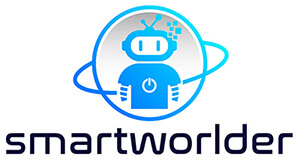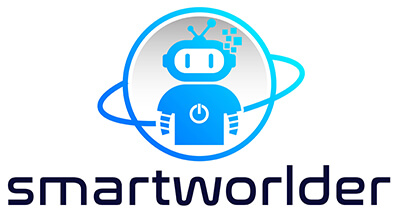Internet of Things Explained – everything you need to know about the internet-of-things
Content
The crucial component making smart technologies possible – from something as small as a ring to as large as an entire city – is the Internet of Things (IoT).
The Internet of Things (IoT) refers to the network of physical objects (devices, vehicles, equipment, buildings, etc.) that are connected to the internet and can collect and exchange data using sensors and other technologies. The IoT allows these objects to be monitored and controlled remotely, enabling a wide range of new applications and services.
And what does IoT mean, exactly? Although there are varying definitions, the term IoT is mainly used for previously 'dumb' devices that didn’t have an Internet connection, but that now communicate with the network independently of human action. For this reason, a smartphone isn’t explicitly defined as an IoT device – although it’s crammed with sensors. A connected refrigerator, microwave oven or streetlight however is.
Nowadays, these smart technology devices include billions of objects of all shapes and sizes – coffee machines, lightbulbs, driver-less trucks, wearable fitness devices, jet engines and children's smart toys – all equipped with sensors and communicating data through the Internet.
There even is a smart basketball with sensors that track your shots.
From the first ‘thing’ connected to the Internet to 75 billion IoT devices in 2025
The first 'thing' on the Internet was created in 1982: a soda machine at Carnegie Mellon University in Pittsburgh, Pennsylvania, that reported on the number and the temperature of the drinks it contained.
In 1999, British technologist Kevin Ashton coined the term Internet of Things to define a network that not only connects people, but also the objects around them – like that Coke machine at CMU. According to Ashton, “the IoT network integrates the interconnectedness of human culture – our 'things' – with the interconnectedness of our digital information system – the internet.”
At the time, most people thought this was the stuff of science fiction films. Today, IoT technology has become a reality, thanks to the development of communication technologies, data analytics, and ever more sophisticated algorithms.

At some point in 2008 or 2009, IoT connected devices came to exceed the world’s human population. Since then, the IoT has become a vast network of connected objects collecting and analyzing huge amounts of data and autonomously performing tasks. An estimated more than 35 billion devices will be connected by the end of 2021 to this data network worldwide. IoT examples are sensors of all kinds, household appliances, machines, wind turbines, medical devices, TVs, watches, cars, traffic and street lights, industrial machinery, car componets, and much more.
According to predictions, the number of IoT connected devices will grow dramatically to 75 billion in 2025 and a staggering 125 billion by 2030. At that point, there will be almost 15 things connected to the Internet for each human on earth.
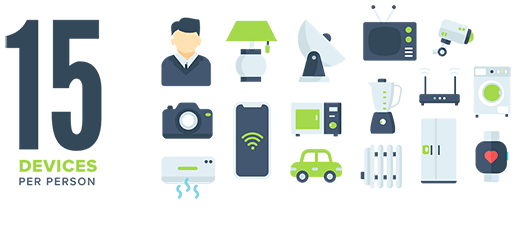
However, the main factor of this growth is not the population of the world but the explosion of connected devices.
Successful IoT devices will integrate seamlessly into our lives and our homes until we forget that they are there and that we once did these tasks manually. Opportunities arise from invisible hardware which works (together) autonomously, automatically adjusts settings or intuitively via voice control.
Why is Internet of Things (IoT) so important?
The Internet of Things impacts everything from the way we travel and do our shopping to the way we keep fit. But how exactly does it work?
As billions of 'dumb' inanimate objects have become 'smart', and billions more are added every year, the IoT is now at work all around us. RFID tags track produce from harvest to store shelf; GPS systems guide cars, ships and planes to their destinations; streetlights dim when there is no car nearby; smart room controls turn off heat, air conditioning and lights when rooms are unoccupied.
Industries and governments now use IoT to understand consumer needs in real time; become more responsive; improve production processes and entire factory efficiencies; transform communities into smart cities.
The Basic Elements of the Internet-of-Things
There are several key components that are essential to the functioning of the Internet of Things. These include:
Sensors and devices: These are the "things" in the Internet of Things, and they are equipped with sensors that can collect data about their environment, such as temperature, humidity, and motion.
Network connectivity: In order for the sensors and devices to communicate with each other and with the wider internet, they need to be connected to a network. This could be a local area network (LAN), a wide area network (WAN) such as the internet, or a combination of both.
Data storage and processing: The data collected by the sensors and devices needs to be stored somewhere, and often needs to be processed in order to be useful. This is typically done using servers and cloud computing resources.
User interfaces: In order for people to interact with the IoT system, there needs to be some kind of user interface, such as a smartphone app or a web-based dashboard.
Security: Ensuring the security of an IoT system is critical, as it involves sensitive data and the potential for malicious actors to compromise the system.
It is difficult to identify a single most important component of the Internet of Things as the system is made up of many interconnected parts that all play a crucial role. However, some components could be considered more essential than others, depending on the specific application of the IoT system.
For example, if the primary purpose of the IoT system is to collect and analyze data, then sensors and devices, data storage and processing, and possibly user interfaces might be considered the most important components. On the other hand, if the main focus of the IoT system is on automation and control, then network connectivity and user interfaces might be considered the most important components.
Ultimately, the importance of each component will depend on the specific needs and goals of the IoT system, and the ways in which the various components work together to achieve those goals.
Sensors
Data-collecting sensors embedded in all kinds of devices are at the core of IoT applications. Individual sensors vary widely, depending on their intended use.
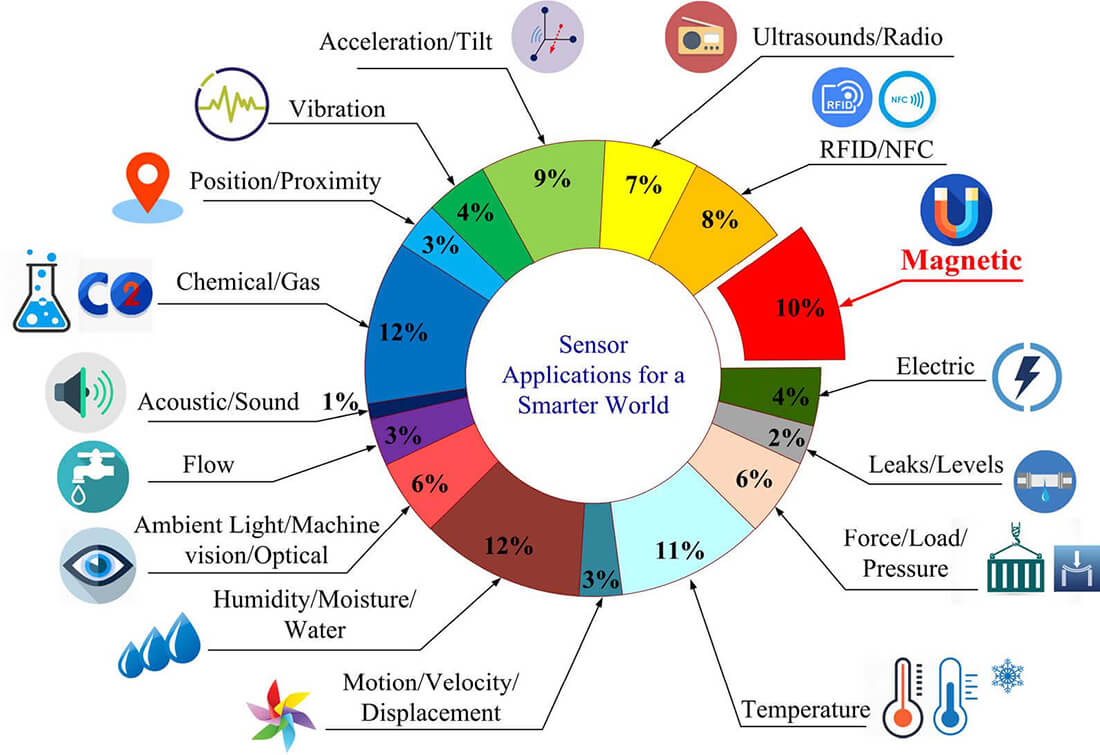
New York City’s Internet of Things strategy paper groups sensors the following categories:
Environmental: These sensors are typically specialized and focused on collecting a specific type of data point, such as temperature, humidity, water or air quality, presence of gas and chemicals, or radiation, among others.
Vision: Vision-based sensors can be adapted for multiple types of data, as such a sensor is essentially a camera that can be trained to “look” for an array of data types. Examples include object classification (person, vehicle, object, etc.), blob (basic object) detection, color detection, facial recognition, or infrared and heat detection, among others.
Acoustic: Like vision-based sensors, acoustic sensors are adaptable to different scenarios where a microphone is listening for certain stimuli. An acoustic sensor might be listening to classify different types of similar sounds, like the differences between various engines’ noise, or it could be listening for a particular type of sound like gunfire. Acoustic sensors are also used in voice assistant technology to listen for “wake” words that activate their language processing functions.
Electrical: Electrical sensors take measurements of voltages and current in electrical systems. These would be implemented when trying to determine energy use or production like with “smart meters,” as well as when diagnosing whether or not a machine is functioning properly.
Motion/Proximity/Presence: These sensors typically measure the presence of or the distance to something or someone. Motion sensors often detect people, and proximity sensors can detect the presence and distance of objects – for example, water levels in a flood zone, or the presence of a vehicle in a parking space.
Location: Location sensors, typically based on GPS technology, allow for objects or individuals to be located or tracked. These sensors can be used to track vehicles in a fleet (buses, trucks) or sensitive assets being shipped, such as medical supplies in a cold chain.
Radio: Radio-based sensors encompass many different types of technologies and applications. For example, Bluetooth Low-Energy (BLE) beacons can send information to a smartphone about the user’s location (wayfinding) and Radio-Frequency Identification (RFID) cards and tags can be used to gain access to buildings or pay tolls and monitor traffic flow.
Biometric/Biomedical: These sensors detect physiological data that are either static and unchanging (biometric) or fluctuate over time (biomedical). Biometric sensors measure unique personal traits such as fingerprints, retinal scans, voice prints, or facial features. They are most commonly used for identification purposes, often as a security measure. Biomedical sensors often look at physical vital signs like heart rate, blood oxygen levels, electrocardiograms, and are typically diagnostic in nature. Biometric sensors are commonly used in wearable technology like fitness trackers and smartwatches.
Data
The data that is collected by these sensors can be sorted into categories to be used by different groups of users. Some examples as they relate to a smart city environment:
Environmental: Environmental data are collected from sensors located in a physical area of interest, either indoors or outdoors, and can represent natural or manmade inputs such as temperature, air quality, or sound levels.
Transportation/Mobility: Transportation and mobility data can represent many aspects of how people get around like utilization of mobility infrastructure, number of pedestrians, or flow of vehicles on city streets. There is often a connection between mobility data and location data.
Location: Location data are typically represented by coordinates created by a Global Positioning System (GPS) device. Real-time location can be provided to track the whereabouts of people, animals, vehicles, or other mobile objects.
Energy: Energy data can represent the amount of energy a system produces, how much energy is being used, or the status of a heating/cooling system or lighting fixture.
Infrastructure: Infrastructure data represent the status of infrastructure or machinery. This could be represented by connected trash receptacles, water pipes, building occupancy, or other such data points relating to built infrastructure.
Biometric / Health: Biometric or health data represent information about a physical trait or characteristic of an individual and can be used as identifying information, for example: a fingerprint, face, or individual’s gait, etc. Health data represent short or long-term information about an individual’s or population’s overall health as it changes over time. This can be captured through a wearable device or through aggregate sampling, as in municipal wastewater.
Analytics
Once data are collected, IoT systems typically analyze those data to make them more useful and actionable. IoT analytics can be performed either on the device or in the cloud, and analysis may be presented as information in the form of dashboards, tables, alerts, or recommendations. There are basically two ways how IoT data can be analyzed.
Descriptive analytics are the simplest and most straightforward form of IoT data analytics. They consist of capturing and describing the actual recorded data, such as temperature readings over time. Data can be presented in tables or through charts and graphs. Very basic data processing functions, such as calculating averages, are also considered 'descriptive' in nature.
Predictive analytics, as the name implies, aim to predict outcomes based on historical data. Prescriptive analytics aim to take collected data and translate them into actionable recommendations for users. Examples include predicting whether or not a pipe might burst based on measured leakage data or predicting when a machine component like a motor might fail based on a change in performance. In both instances, the prediction can spur preemptive maintenance to avoid an equipment or system failure.
Who is Using IoT and how? Some Examples
Consumer Applications
The most common areas where a person comes in touch with smart technology is in the home or through wearables.
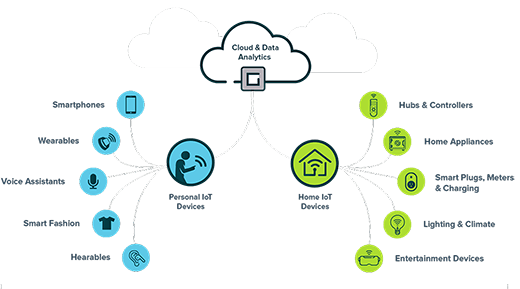
Industrial Internet of Things (IIoT)
IoT connects all phases of the Industrial Internet of Things process from supply chain, factory machinery and warehouse shelves, to delivery, providing companies with a cohesive view of their production, operations processes, and product data. IIoT combined with big data analytics and predictive modeling can prevent defects and downtime, maximize equipment performance, optimize just-in-time delivery, cut warranty costs, boost production yield and enhance the customer experience.
Retail
IoT unites data, analytics and marketing processes across locations. Retailers capture data from product-embedded RFID chips, smart shelves, in-store and digital channels and apply analytics to understand customer behavior patterns and preferences – often in real-time.
Logistics Sector
Logistics companies can achieve greater efficiency and reliability across their operations by using IoT with location-based services provided by radio frequency identification (RFID), Wi-Fi, GPS, or cellular data, combines with artificial intelligence algorithms.
This technology can improve service quality, enhance safety and reduce downtime and costs by tracking and monitoring individual fleet vehicles, freight and other mobile assets in real time.
Energy Sector
The electric infrastructure (“electric grid”) is more than just power plants and transmission lines. It is an ecosystem of asset owners, manufacturers, service providers, and government officials.
The interconnection of IoT devices, vehicles, and buildings, offers the promise of advanced services stemming from new connections between digital and physical grid systems based on improved communication and control technologies.
These technologies include control, learning, and distributed optimization algorithms, which will enable energy utilities to improve crucial grid services such as load flexibility, voltage/frequency regulation, and situation-awareness. IoT will integrate distributed grid resources like solar and wind.
Utilities’ internal data combined with users’ behavior data collected from smart homes improves convenience and security and informs development of customized services and novel pricing structures.
Health Care
The Internet of Medical Things (IoMT) is an IoT-based network of monitoring and medical devices (mostly wearables), software applications, and health related services. It connects people and institutions related to health care (doctor’s offices, hospitals, insurance companies, government agencies) to promote interaction between all parties to ensure that participants get the services they need based on informed decisions and facilitates the rational allocation of resources. It streamlines the data flow across the entire system from patient to insurers and, when needed like in the Covid-19 pandemic, to government agencies and research organizations.
Government
'Smart City' has become a big buzzword over the past years and many cities around the world are experimenting with smart infrastructure and services. Read more here in our article Smart Cities Explained.
What is Driving the Explosive Growth of IoT?
The explosive growth of the IoT has been fueled by a number of developments: cost, network protocols, cloud computing platforms, machine learning-based analytics, and AI.
The average cost of IoT sensor technology has fallen by 75% over the past 15 years, making their widespread use attractive for more and more manufacturers and service providers.

The development of Internet network protocols (IPs) has made it easy to connect sensors to the cloud and to other IoT devices for efficient data transfer. An IP is a set of rules that dictates how data gets sent to the Internet. Different IoT protocols have been designed and optimized for different scenarios and usage. These protocols ensure that information from one device or sensor gets read and understood by another device, a gateway, a service.
The type of connectivity that is utilized by an IoT protocol depends on the device, its function, and its users. Typically, the distance that the data must travel (short-range or long-range) determines the type of IoT connectivity needed.
Low-power, short-range networks are well-suited for homes, offices, and other small environments. They tend to only need small batteries and are usually inexpensive to operate. Examples are Bluetooth, NFC, Wi-Fi/802.11, Z-Wave and Zigbee.
Low-power, wide-area networks (LPWAN) enable communication across a minimum of 500 meters, require minimal power, and are used for a majority of IoT devices. Common examples of LPWANs are 4G LTE IoT, 5G IoT, Cat-0, Cat-1, LTE Cat-M1, LoRaWAN, NB-IoT/Cat-M2, and Sigfox.
Data collected from IoT devices moves through a gateway, gets preprocessed at the edge, and then gets sent to cloud computing platforms. The growing number of IoT Cloud Platforms in the market has made more services available at a lower cost, which means that businesses and consumers can access the infrastructure they need to scale up without actually having to manage it all. Service providers (such as Microsoft, Siemens, Oracle, IBM, Amazon, Google) usually build IoT clouds on top of generic clouds. In most cases, typical features include connectivity and network management, device management, data acquisition, processing analysis and visualization, application enablement, integration and storage.
IoT systems gather such massive amounts of data that machine learning based analytics become necessary to sort and analyze it all and detect patterns, leading to insights that suggest actions. As these systems become more sophisticated and capable, consumers experience greater levels of benefits and convenience, whereas industrial and professional users see optimization gains across their operations.
For instance, IoT machine learning models designed and trained to identify signals in historical data can be used to identify the same trends in current data. This lets users automate preventative service requests and order new parts ahead of time so that they are always available when needed.
Digital personal assistants such as Amazon’s Alexa, Apple’s Siri and IBM’s Watson show as a future where advances in neural networks will bring widespread natural-language processing to IoT devices. This conversational artificial intelligence (AI) uses large volumes of data, machine learning, and natural language processing to help imitate human interactions, recognizing speech and text inputs and translating their meanings across various languages.
Security Risks of IoT Applications
These all sound very promising and show that 5G technologies can bring many benefits to our everyday lives. The IoT will definitely make our lives easier.
But we shouldn’t ignore the negatives. There's an Internet-of-Things, but also an 'Internet-of-Threat'. Since everything is now connected, that means everything is hackable. Better technologies create a great opportunity for hackers, and open a great future for cyber criminals. (Read more: Criminal intent: How the Internet-of-Things can also be a threat)
Any Internet-enabled device is vulnerable to being hacked and misused. And it appears that this vulnerability is widespread.
According to the 2020 IoT Threat Report by the Palo Alto Networks Unit 42 security consulting team, 98% of all IoT device traffic is unencrypted, exposing personal and confidential data on the network and allowing attackers the ability to listen to unencrypted network traffic, collect personal or confidential information, then exploit that data for profit on the dark web.
Furthermore, 57% of IoT devices are vulnerable to medium- or high-severity attacks, making IoT the low-hanging fruit for attackers, and 41% of attacks exploit device vulnerabilities, as IT-borne attacks scan through network-connected devices in an attempt to exploit known weaknesses.

These existing vulnerabilities drives home the importance for all IoT device and service providers of developing a strong IoT cybersecurity. This includes:
Frequently Asked Questions on IoT
What is the Internet of Things (IoT)?
Answer: The Internet of Things (IoT) refers to a network of interconnected physical devices, vehicles, appliances, and other objects embedded with sensors, software, and network connectivity that enable them to collect and exchange data.
How does the Internet of Things work?
Answer: IoT devices collect data through their embedded sensors, process it locally or transmit it to a central server or cloud platform. The data is then analyzed and used to trigger actions or provide valuable insights.
What are some examples of IoT devices?
Answer: Examples of IoT devices include smart thermostats, wearable fitness trackers, connected home security systems, smart refrigerators, industrial sensors, and even self-driving cars.
How does IoT impact our daily lives?
Answer: IoT has the potential to enhance various aspects of daily life, such as improving home automation, optimizing energy usage, enabling remote monitoring of health conditions, enhancing transportation efficiency, and enabling smart cities with better infrastructure management.
What are the security and privacy concerns associated with IoT?
Answer: Security concerns include unauthorized access to IoT devices, data breaches, and potential vulnerabilities in the software or firmware. Privacy concerns arise from the collection and use of personal data generated by IoT devices.
How does IoT relate to big data and analytics?
Answer: IoT generates massive amounts of data that can be analyzed using big data and analytics techniques. This data analysis can provide valuable insights, patterns, and trends for businesses and organizations.
What are the benefits of adopting IoT technology?
Answer: Some benefits of adopting IoT technology include improved efficiency, cost savings, automation of processes, enhanced decision-making based on real-time data, increased productivity, and improved quality of life.
What are some challenges in implementing IoT solutions?
Answer: Challenges in implementing IoT solutions include interoperability issues among different devices and platforms, scalability concerns, ensuring data security and privacy, managing the vast amount of generated data, and addressing the complexity of integrating IoT with existing systems.
How is IoT being used in different industries?
Answer: IoT is being utilized in various industries, including healthcare (remote patient monitoring), agriculture (smart farming and precision agriculture), manufacturing (predictive maintenance), transportation (fleet management), and retail (smart shelves and inventory tracking), among others.
What is the future of IoT and its potential impact?
Answer: The future of IoT is promising, with the potential for further integration into our daily lives. It will likely lead to more connected devices, increased automation, improved efficiency, and innovative applications across industries.
Also check out our related articles on What is Smart Technology and Smart Cities.
Check out our SmartWorlder section to read more about smart technologies.

